Study on the Tight Gas Accumulation Process and Model in the Transition Zone at the Margin of the Basin: A Case Study on the Permian Lower Shihezi Formation, Duguijiahan Block, Ordos Basin, Northern China
Abstract
1. Introduction
2. Geological Setting
3. Materials and Methods
3.1. Samples and Data
3.2. Methods
3.2.1. Identification for Thin Section of Rocks
3.2.2. Fluid Inclusion Test
3.2.3. Basin Modeling
3.2.4. Digital Simulations of Gas Charging
4. Results
4.1. Reservoir Evolution
4.1.1. Characteristics of Tight Sandstones Reservoir
4.1.2. Porosity Evolution and Densification of Reservoirs
4.2. Process of Hydrocarbon Generation and Charging
4.2.1. Characters of Fluid Inclusions
4.2.2. Hydrocarbon Charging Timing
4.2.3. Gas Charging Process
4.3. Process of Gas Migration
5. Discussion
5.1. Hydrocarbon Accumulation Process
5.1.1. Depositional Stage
5.1.2. Natural Gas Accumulation Stage
5.1.3. Gas Reservoir Adjustment Stage
5.2. Hydrocarbon Accumulation Model in the Transition Zone
6. Conclusions
Author Contributions
Funding
Data Availability Statement
Acknowledgments
Conflicts of Interest
References
- Zou, C.; Zhu, R.; Wu, S.; Yang, Z.; Tao, S.; Yuan, X. Types, characteristics, genesis and prospects of conventional and unconventional hydrocarbon accumulations:taking tight oil and tight gas in China as an instance. Acta Pet. Sin. 2012, 33, 173–187. [Google Scholar] [CrossRef]
- Arthur, M.A.; Cole, D.R. Unconventional Hydrocarbon Resources: Prospects and Problems. Elements 2014, 10, 257–264. [Google Scholar] [CrossRef]
- Kang, Y.; Zhou, L. The strategic thinking of unconventional petroleum and gas in China. Earth Sci. Front. 2016, 23, 1–7. (In Chinese) [Google Scholar] [CrossRef]
- Dai, J.; Ni, Y.; Wu, X. Tight gas in China and its significance in exploration and exploitation. Pet. Explor. Dev. 2012, 39, 277–284. [Google Scholar] [CrossRef]
- Jia, C. Breakthrough and significance of unconventional oil and gas to classical petroleum geology theory. Pet. Explor. Dev. 2017, 44, 1–10. [Google Scholar] [CrossRef]
- Zou, C.; Yang, Z.; He, D.; Wei, Y.; Li, J.; Jia, A.; Chen, J.; Zhao, Q.; Li, Y.; Li, J.; et al. Theory, technology and prospects of conventional and unconventional natural gas. Pet. Explor. Dev. 2018, 45, 604–618. [Google Scholar] [CrossRef]
- Masters, J.A. Deep Basin Gas Trap, Western Canada. AAPG Bull. 1979, 63, 152–181. [Google Scholar] [CrossRef]
- Hart, B.S. Seismic expression of fracture-swarm sweet spots, Upper Cretaceous tight-gas reservoirs, San Juan Basin. AAPG Bull. 2006, 90, 1519–1534. [Google Scholar] [CrossRef]
- Ryder, R.T.; Zagorski, W.A. Nature, origin, and production characteristics of the Lower Silurian regional oil and gas accumulation, central Appalachian basin, United States. AAPG Bull. 2003, 87, 847–872. [Google Scholar] [CrossRef]
- Guo, X.; Liu, K.; Jia, C.; Song, Y.; Zhao, M.; Zhuo, Q.; Lu, X. Hydrocarbon accumulation processes in the Dabei tight-gas reservoirs, Kuqa Subbasin, Tarim Basin, northwest China. AAPG Bull. 2016, 100, 1501–1521. [Google Scholar] [CrossRef]
- Zhao, S.; Chen, W.; Wang, Z.; Li, T.; Wei, H.; Ye, Y. Fluid geochemistry of the Jurassic Ahe Formation and implications for reservoir formation in the Dibei area, Tarim Basin, northwest China. Energy Explor. Exploit. 2018, 36, 801–819. [Google Scholar] [CrossRef]
- Yang, Z.; He, S.; Guo, X.; Li, Q.; Chen, Z.; Zhao, Y. Formation of low permeability reservoirs and gas accumulation process in the Daniudi Gas Field, Northeast Ordos Basin, China. Mar. Pet. Geol. 2015, 70, 222–236. [Google Scholar] [CrossRef]
- Peng, W.; Guo, F.; Hu, G.; Lyu, Y.; Gong, D.; Liu, J.; Feng, Z.; Guo, J.; Guo, Y.; Han, W. Geochemistry and accumulation process of natural gas in the Shenmu Gas Field, Ordos Basin, central China. J. Pet. Sci. Eng. 2019, 180, 1022–1033. [Google Scholar] [CrossRef]
- Wu, H.; Zhao, J.; Wu, W.; Li, J.; Huang, Y.; Chen, M. Formation and diagenetic characteristics of tight sandstones in closed to semi-closed systems: Typical example from the Permian Sulige gas field. J. Pet. Sci. Eng. 2020, 199, 108248. [Google Scholar] [CrossRef]
- Hao, L.; Ma, X.; Gao, W.; Ren, Z.; Tao, H.; Huang, W. Geochemical Characteristics of the Chang 7 Source Rocks of the Triassic Yanchang Formation in Ordos Basin, China: Implications for Organic Matter Accumulation and Shale Oil Potential. Energies 2022, 15, 7815. [Google Scholar] [CrossRef]
- Xu, Z.; Jiang, S.; Liu, L.; Wu, K.; Li, R.; Liu, Z.; Shao, M.; Jia, K.; Feng, Y. Natural gas accumulation processes of tight sandstone reservoirs in deep formations of Songliao Basin, NE China. J. Nat. Gas Sci. Eng. 2020, 83, 103610. [Google Scholar] [CrossRef]
- Wang, Q.; Chen, D.; Wang, F.; Gao, X.; Zou, Y.; Tian, Z.; Li, S.; Chang, S.; Yao, D. Origin and distribution of an under-pressured tight sandstone reservoir: The Shaximiao Formation, Central Sichuan Basin. Mar. Petrol. Geol. 2021, 132, 121–128. [Google Scholar] [CrossRef]
- Zhao, X.; Zeng, J.; Han, G.; Feng, S.; Shi, Q.; Liu, Y.; Fu, D.; Wang, Y.; Zong, J.; Lu, Y. Charging characteristics and accumulation process of deep low-permeability (tight) sand gas reservoirs in Banqiao Sag, Huanghua Depression. Oil Gas Geol. 2020, 41, 15. (In Chinese) [Google Scholar] [CrossRef]
- Zhou, X.; Xu, G.; Cui, H.; Zhang, W. Fracture development and hydrocarbon accumulation in tight sandstone reservoirs of the Paleogene Huagang Formation in the central reversal tectonic belt of the Xihu Sag, East China Sea. Pet. Explor. Dev. 2020, 47, 499–512. [Google Scholar] [CrossRef]
- Yu, Z.; Wang, Z.; Adenutsi, C.D. Genesis of authigenic clay minerals and their impacts on reservoir quality in tight conglomerate reservoirs of the Triassic Baikouquan formation in the Mahu Sag, Junggar Basin, Western China. Mar. Pet. Geol. 2023, 148, 106041. [Google Scholar] [CrossRef]
- Xia, L.; Cao, Y.; Bian, B.; Liu, H.; Wang, X.; Zhao, Y.; Yan, M. Genesis of calcite vein in basalt and its effect on reservoir quality: A case study of the Carboniferous in the east slope of Mahu sag, Junggar Basin, NW China. Pet. Explor. Dev. 2021, 48, 864–876. [Google Scholar] [CrossRef]
- Jia, J.; Yin, W.; Qiu, N.; Wang, G.; Ma, L.; Liu, Y.; Liu, N. Migration and accumulation of crude oil in Upper Triassic tight sand reservoirs on the southwest margin of Ordos Basin, Central China: A case study of the Honghe Oilfield. Geol. J. 2017, 53, 2280–2300. [Google Scholar] [CrossRef]
- Zhi, D.; Tang, Y.; He, W.; Guo, X.; Zheng, M.; Huang, L. Orderly coexistence and accumulation models of conventional and unconventional hydrocarbons in Lower Permian Fengcheng Formation, Mahu sag, Junggar Basin. Pet. Explor. Dev. 2021, 48, 43–59. [Google Scholar] [CrossRef]
- Liu, C.; Wang, J.; Zhang, D.; Zhao, H.; Zhao, J.; Huang, L.; Wang, W.; Qin, Y. Genesis of rich hydrocarbon resources and their occurrence andaccumulation characteristics in the Ordos Basin. Oil Gas Geol. 2021, 42, 1011–1029. (In Chinese) [Google Scholar] [CrossRef]
- Yang, H.; Fu, J.; Wei, X.; Liu, X. Sulige field in the Ordos Basin: Geological setting, field discovery and tight gas reservoirs. Mar. Pet. Geol. 2008, 25, 387–400. [Google Scholar] [CrossRef]
- Liu, Q.; Jin, Z.; Meng, Q.; Wu, X.; Jia, H. Genetic types of natural gas and filling patterns in Daniudi gas field, Ordos Basin, China. J. Asian Earth Sci. 2015, 107, 1–11. [Google Scholar] [CrossRef]
- Huang, S.; Fang, X.; Liu, D.; Fang, C.; Huang, T. Natural gas genesis and sources in the Zizhou gas field, Ordos Basin, China. Int. J. Coal Geol. 2015, 152, 132–143. [Google Scholar] [CrossRef]
- Min, Q.; Fu, J.; Xi, S.; Liu, X.; Wang, T.; Ji, H.; Li, Y. Characteristics of natural gas migration and accumulation in the Upper Paleozoic of Ordos basin. Pet. Explor. Dev. 2000, 27, 26–29. (In Chinese) [Google Scholar]
- Li, L.; Yuan, Z.; Hui, K.; Liu, S. Accumulation regularity of Upper Paleozoic gas in north Ordos Basin. Oil Gas Geol. 2000, 21, 268–271. (In Chinese) [Google Scholar] [CrossRef]
- Hong, F.; Song, Y.; Zhao, L. Controlling factors of gas reservoir formation in the north of Ordos Basin. Nat. Gas Ind. 1998, 18, 22–25. (In Chinese) [Google Scholar]
- Zhang, J.; Chang, X.; Zhang, J. Deep basin gas trap in the Upper Paleozoic of Ordos basin. Pet. Explor. Dev. 2000, 27, 30–35. (In Chinese) [Google Scholar]
- Wang, Z.; Zhang, J. Mechanism of deep basin gas accumulation in the Upper Paleozoic in Ordos Basin. Nat. Gas Ind. 2006, 26, 52–54. (In Chinese) [Google Scholar]
- Wang, R.; Liu, K.; Shi, W.; Qin, S.; Zhang, W.; Qi, R.; Xu, L. Reservoir Densification, Pressure Evolution, and Natural Gas Accumulation in the Upper Paleozoic Tight Sandstones in the North Ordos Basin, China. Energies 2022, 15, 1990. [Google Scholar] [CrossRef]
- Mingjian, W.; Dengfa, H.; Hongping, B.; Renqi, L.; Baoling, G. Upper Palaeozoic gas accumulations of the Yimeng Uplift, Ordos Basin. Pet. Explor. Dev. 2011, 38, 30–39. [Google Scholar] [CrossRef]
- Yang, H.; Fu, J.; Liu, X.; Meng, P. Accumulation conditions and exploration and development of tight gas in the Upper Paleozoic of the Ordos Basin. Pet. Explor. Dev. 2012, 39, 315–324. [Google Scholar] [CrossRef]
- Yang, M.; Li, L.; Zhou, J.; Jia, H.; Sun, X.; Qu, X.; Zhou, D.; Gong, T.; Ding, C. Mesozoic structural evolution of the Hangjinqi area in the northern Ordos Basin, North China. Mar. Pet. Geol. 2015, 66, 695–710. [Google Scholar] [CrossRef]
- Xu, Q.; Shi, W.; Xie, X.; Busbey, A.B.; Xu, L.; Wu, R.; Liu, K. Inversion and propagation of the Late Paleozoic Porjianghaizi fault (North Ordos Basin, China): Controls on sedimentation and gas accumulations. Mar. Pet. Geol. 2018, 91, 706–722. [Google Scholar] [CrossRef]
- Yang, Y.; Li, W.; Ma, L. Tectonic and stratigraphic controls of hydrocarbon systems in the Ordos basin: A multicycle cratonic basin in central China. AAPG Bull. 2005, 89, 255–269. [Google Scholar] [CrossRef]
- Hanson, A.D.; Ritts, B.D.; Moldowan, J.M. Organic geochemistry of oil and source rock strata of the Ordos Basin, north-central China. AAPG Bull. 2007, 91, 1273–1293. [Google Scholar] [CrossRef]
- Gao, J.; Ma, B.; Lu, Y.; Zhang, W.; Cao, Q. Origin of authigenic kaolinite with implications for Permian tight gas sandstone reservoirs in the northern Ordos Basin, central China. J. Nat. Gas Sci. Eng. 2022, 99, 104429. [Google Scholar] [CrossRef]
- Guo, Z.; Zhang, J.; Yu, Z. The evolutional characteristics of structure of the oil and gas bearing areas in Ordos Massif. Pet. Explor. Dev. 1994, 21, 22–29. (In Chinese) [Google Scholar]
- Xiao, X.; Zhao, B.; Thu, Z.; Song, Z.; Wilkins, R. Upper Paleozoic petroleum system, Ordos Basin, China. Mar. Pet. Geol. 2005, 22, 945–963. [Google Scholar] [CrossRef]
- Yang, H.; Xi, S.; Wei, X.; Li, Z. Evolution and Natural Gas Enrichment of Multicycle Superimposed Basin in Ordos Basin. China Pet. Explor. 2006, 11, 17–24. (In Chinese) [Google Scholar]
- Zhang, L.; Liu, C.; Fayek, M.; Wu, B.; Lei, K.; Cun, X.; Sun, L. Hydrothermal mineralization in the sandstone–hosted Hangjinqi uranium deposit, North Ordos Basin, China. Ore Geol. Rev. 2017, 80, 103–115. [Google Scholar] [CrossRef]
- Wang, G.; Chang, X.; Yin, W.; Li, Y.; Song, T. Impact of diagenesis on reservoir quality and heterogeneity of the Upper Triassic Chang 8 tight oil sandstones in the Zhenjing area, Ordos Basin, China. Mar. Pet. Geol. 2017, 83, 84–96. [Google Scholar] [CrossRef]
- Lai, J.; Wang, S.; Wang, G.; Shi, Y.; Zhao, T.; Pang, X.; Fan, X.; Qin, Z.; Fan, X. Pore structure and fractal characteristics of Ordovician Majiagou carbonate reservoirs in Ordos Basin, China. AAPG Bull. 2019, 103, 2573–2596. [Google Scholar] [CrossRef]
- Liu, D.; Li, J.; Liu, J.-Q.; Zhang, L. Modeling hydrocarbon accumulation based on gas origin and source rock distribution in Paleozoic strata of the Ordos Basin, China. Int. J. Coal Geol. 2020, 225, 103486. [Google Scholar] [CrossRef]
- Li, H.-Y.; He, B.; Xu, Y.-G.; Huang, X.-L. U–Pb and Hf isotope analyses of detrital zircons from Late Paleozoic sediments: Insights into interactions of the North China Craton with surrounding plates. J. Asian Earth Sci. 2010, 39, 335–346. [Google Scholar] [CrossRef]
- Yang, M.; Li, L.; Zhou, J.; Qu, X.; Zhou, D. Segmentation and inversion of the Hangjinqi fault zone, the northern Ordos basin (North China). J. Asian Earth Sci. 2013, 70–71, 64–78. [Google Scholar] [CrossRef]
- Yang, H.; Liu, X.; Yan, X. The relationship between tectonic sedimentary evolution and tight sandstone gas reservoir since the late Paleozoic in Ordos Basin. Earth Sci. Front. 2015, 22, 174–183. [Google Scholar] [CrossRef]
- Xue, H.; Wang, Y.; Mao, X.; Xu, B.; Xia, H.; Yin, Y.; Guo, H. The timing of gas pooling in the Upper Paleozoic in the northern Ordos Basin: A case study of the Hangjinqi Block. Nat. Gas Ind. 2009, 29, 9–12. (In Chinese) [Google Scholar] [CrossRef]
- Dou, W.; Hou, M.; Dong, G. Provenance analysis of the Upper Paleozoic Shanxi to Lower Shihezi formations in north Ordos basin. Nat. Gas Ind. 2009, 29, 25–28. [Google Scholar] [CrossRef]
- Guan, Y.; Guo, Q.; Pu, R.; Gao, X.; Chen, S.; Ji, T. Distribution of Upper Paleozoic Coal Seams in the Southeastern Ordos Basin. Energies 2022, 15, 5110. [Google Scholar] [CrossRef]
- Wang, R.; Shi, W.; Xie, X.; Zhang, W.; Qin, S.; Liu, K.; Busbey, A.B. Clay mineral content, type, and their effects on pore throat structure and reservoir properties: Insight from the Permian tight sandstones in the Hangjinqi area, north Ordos Basin, China. Mar. Pet. Geol. 2020, 115, 104281. [Google Scholar] [CrossRef]
- Qin, S.; Wang, R.; Shi, W.; Liu, K.; Zhang, W.; Xu, X.; Qi, R.; Yi, Z. Diverse effects of intragranular fractures on reservoir properties, diagenesis, and gas migration: Insight from Permian tight sandstone in the Hangjinqi area, north Ordos Basin. Mar. Pet. Geol. 2022, 137, 105526. [Google Scholar] [CrossRef]
- Wu, X.; Ni, C.; Liu, Q.; Liu, G.; Zhu, J.; Chen, Y. Genetic Types and Source of the Upper Paleozoic Tight Gas in the Hangjinqi Area, Northern Ordos Basin, China. Geofluids 2017, 2017, 4596273. [Google Scholar] [CrossRef]
- Anees, A.; Shi, W.; Ashraf, U.; Xu, Q. Channel identification using 3D seismic attributes and well logging in lower Shihezi Formation of Hangjinqi area, northern Ordos Basin, China. J. Appl. Geophys. 2019, 163, 139–150. [Google Scholar] [CrossRef]
- Mao, R.; Mi, J.; Zhang, S.; He, K. Study on the Hydrocarbon Generation Characteristics of Different Coaly Source Rocks by Gold-tube Pyrolysis Experiments. Nat. Gas Geosci. 2012, 23, 1127–1134. (In Chinese) [Google Scholar] [CrossRef]
- Zhao, G.P. Characterization of fluid inclusions and timing of gas accumulation in Upper Paleozoic reservoirs of Hangjinqi area, Ordos Basin. Oil Gas Geol. 2017, 38, 905–912. (In Chinese) [Google Scholar] [CrossRef]
- Ren, Z.; Qi, K.; Li, J.; Huo, X.; Cui, J.; Yang, P.; Wang, K.; Chen, Z.; Yang, G. Thermodynamic evolution and hydrocarbon accumulation in the Ordos Basin. Oil Gas Geol. 2021, 42, 1030–1042. (In Chinese) [Google Scholar] [CrossRef]
- Wang, H.; Zhao, G.; Lu, S.; Li, L.; Zhang, W.; Liu, J. Investigation on hydrocarbon generation and expulsion potential by deep learning and comprehensive evaluation method: A case study of Hangjinqi area, Ordos Basin. Mar. Pet. Geol. 2022, 144, 105841. [Google Scholar] [CrossRef]
- Waples, D.W.; Kamata, H.; Suizu, M. The art of maturity modeling. Part 1: Alternative models and sensitivity analysis. AAPG Bull. 1992, 76, 47–66. [Google Scholar]
- Liu, Y.; Ye, J.; Zong, J.; Wang, D.; Cao, Q.; Yang, B.; Li, W.; Zhao, J. Analysis of forces during tight oil charging and implications for the oiliness of the tight reservoir: A case study of the third member of the Palaeogene Shahejie Formation, Qibei slope, Qikou sag. Mar. Pet. Geol. 2022, 144, 105819. [Google Scholar] [CrossRef]
- Liu, T.; Jin, X.; Wang, M. Critical Resolution and Sample Size of Digital Rock Analysis for Unconventional Reservoirs. Energies 2018, 11, 1798. [Google Scholar] [CrossRef]
- Bernaschi, M.; Fatica, M.; Melchionna, S.; Succi, S.; Kaxiras, E. A flexible high-performance Lattice Boltzmann GPU code for the simulations of fluid flows in complex geometries. Concurr. Comput. Pract. Exp. 2009, 22, 1–14. [Google Scholar] [CrossRef]
- Folk, R.L.; Andrews, P.B.; Lewis, D.W. Detrital sedimentary rock classification and nomenclature for use in New Zealand. N. Z. J. Geol. Geophys. 1970, 13, 937–968. [Google Scholar] [CrossRef]
- Zhang, Y.; Tian, J.; Zhang, X.; Li, J.; Liang, Q.; Zheng, X. Diagenesis Evolution and Pore Types in Tight Sandstone of Shanxi Formation Reservoir in Hangjinqi Area, Ordos Basin, Northern China. Energies 2022, 15, 470. [Google Scholar] [CrossRef]
- Qian, W.; Sun, Q.; Jones, S.J.; Yin, T.; Zhang, C.; Xu, G.; Hou, G.; Zhang, B. Diagenesis and controlling factors of Oligocene Huagang Formation tight sandstone reservoir in the south of Xihu sag, the East China Sea Shelf Basin. J. Pet. Sci. Eng. 2022, 215, 110579. [Google Scholar] [CrossRef]
- He, Y.; Guo, H.; Lan, H.; Ling, C.; Fu, M. The Effect of Single Sandstone Stacking Pattern on the Sandstone Reservoir Physical Properties—A Case Study from the Shanxi Formation in the Daniudi Area, Northeastern Ordos Basin. Energies 2022, 15, 4740. [Google Scholar] [CrossRef]
- Zhao, G.; Li, X.; Liu, M.; Dong, C.; Chen, D.; Zhang, J. Reservoir Characteristics of Tight Sandstone and Sweet Spot Prediction of Dibei Gas Field in Eastern Kuqa Depression, Northwest China. Energies 2022, 15, 3135. [Google Scholar] [CrossRef]
- Beard, D.C.; Weyl, P.K. Influence of Texture on Porosity and Permeability of Unconsolidated Sand. AAPG Bull. 1973, 57, 349–369. [Google Scholar] [CrossRef]
- Schmoker, J.W.; Gautier, D.L. Sandstone porosity as a function of thermal maturity. Geology 1988, 16, 1007–1010. [Google Scholar] [CrossRef]
- Wang, Z.; Wei, L.; Wang, X.; Wang, N.; Fan, C.; Li, Y.; Zhao, X.; Zhao, X.; Ren, L.; Cao, H. Accumulation process and mechanism of Lower Paleozoic gas reservoir in Yan’an area, Ordos Basin. Acta Pet. Sin. 2016, 37, 99–110. (In Chinese) [Google Scholar] [CrossRef]
- Li, W.; Qin, S.; Hu, G.; Gong, Y. Accumulation of water-soluble gas by degasification: One of important mechanisms of large gas accumulations in the Xujiahe Formation, Sichuan Basin. Pet. Explor. Dev. 2011, 38, 662–670. [Google Scholar] [CrossRef]
- Ni, C.; Bao, J.; Liu, G.; Zhu, J.; Wu, X.; Zhai, C. A discussion on the influence factors of dryness coefficient of coal-derived gas: A case from the Upper Paleozoic reservoir in northern Ordos Basin. Oil Gas Geol. 2017, 38, 1098–1104. (In Chinese) [Google Scholar] [CrossRef]
- Bai, D.; Yang, M.; Lei, Z.; Zhang, Y. Effect of tectonic evolution on hydrocarbon charging time: A case study from Lower Shihezi Formation (Guadalupian), the Hangjinqi area, northern Ordos, China. J. Pet. Sci. Eng. 2020, 184, 106465. [Google Scholar] [CrossRef]
- He, F.; Wang, F.; Guo, L.; An, C. Evolution of prototype basin and change of tectonic-sedimentary pattern in Paleozoic, Ordos Basin. Pet. Geol. Exper. 2022, 44, 373–384. [Google Scholar] [CrossRef]
- Li, Z.; Ye, J.; Cao, Q.; Yu, H.; Zhang, W. Reservoir characteristics and pore evolution of the Lower Shihezi Formation in Duguijiahan zone, Hangjinqi area, Ordos Basin. Bull. Geol. Sci. Technol. 2021, 40, 49–60. (In Chinese) [Google Scholar] [CrossRef]
- He, F.; Wang, F.; Zhang, W.; An, C.; Qi, R.; Ma, C.; Chen, Y.; Li, C.; Fan, L.; Gui, P. Transformation of exploration ideas and major breakthrough in natural gas discovery in the northern margin of the Ordos Basin. China Pet. Explor. 2020, 25, 39–49. (In Chinese) [Google Scholar] [CrossRef]
- Hao, S.; Li, L.; Zhang, W.; Qi, R.; Ma, C.; Chen, J. Forming conditions of large-scale gas fields in Permo-Carboniferous in the northern Ordos Basin. Oil Gas Geol. 2016, 37, 149–154. (In Chinese) [Google Scholar] [CrossRef]
- Chen, R.; Luo, X.; Chen, Z.; Wang, Z.; Zhou, B. Estimation of Denudation Thickness of Mesozoic Stata in the Ordos Basin and Its Geological Significance. Acta Geol. Sin. 2006, 80, 685–693. (In Chinese) [Google Scholar]
- Li, R.; Li, Y. Tectonic evolution of the western margin of the Ordos Basin (Central China). Russ. Geol. Geophys. 2008, 49, 23–27. [Google Scholar] [CrossRef]
- Ghosh, K.; Mitra, S. Structural controls of fracture orientations, intensity, and connectivity, Teton anticline, Sawtooth Range, Montana. AAPG Bull. 2009, 93, 995–1014. [Google Scholar] [CrossRef]
- Smart, K.J.; Ferrill, D.A.; Morris, A.P. Impact of interlayer slip on fracture prediction from geomechanical models of fault-related folds. AAPG Bull. 2009, 93, 1447–1458. [Google Scholar] [CrossRef]
- Wang, X. Low permeability tight oil and gas in Yanchang area, Ordos Basin: Advances in accumulation theory and exploration practice. Earth Sci. Front. 2022, 30, 143–155. [Google Scholar] [CrossRef]
- Wang, R.; Sun, W. A Study on Micro Cracks in Super Low Permeability Sandstone Reservoir of the Upper Triassic Yanchang Formation in the Ordos Basin. Geol. Rev. 2009, 55, 444–448. (In Chinese) [Google Scholar]
- Zhang, X.; Shi, W.; Hu, Q.; Zhai, G.; Wang, R.; Xu, X.; Xu, Z.; Meng, F.; Liu, Y. Pressure–dependent fracture permeability of marine shales in the Northeast Yunnan area, Southern China. Int. J. Coal Geol. 2019, 214, 103237. [Google Scholar] [CrossRef]
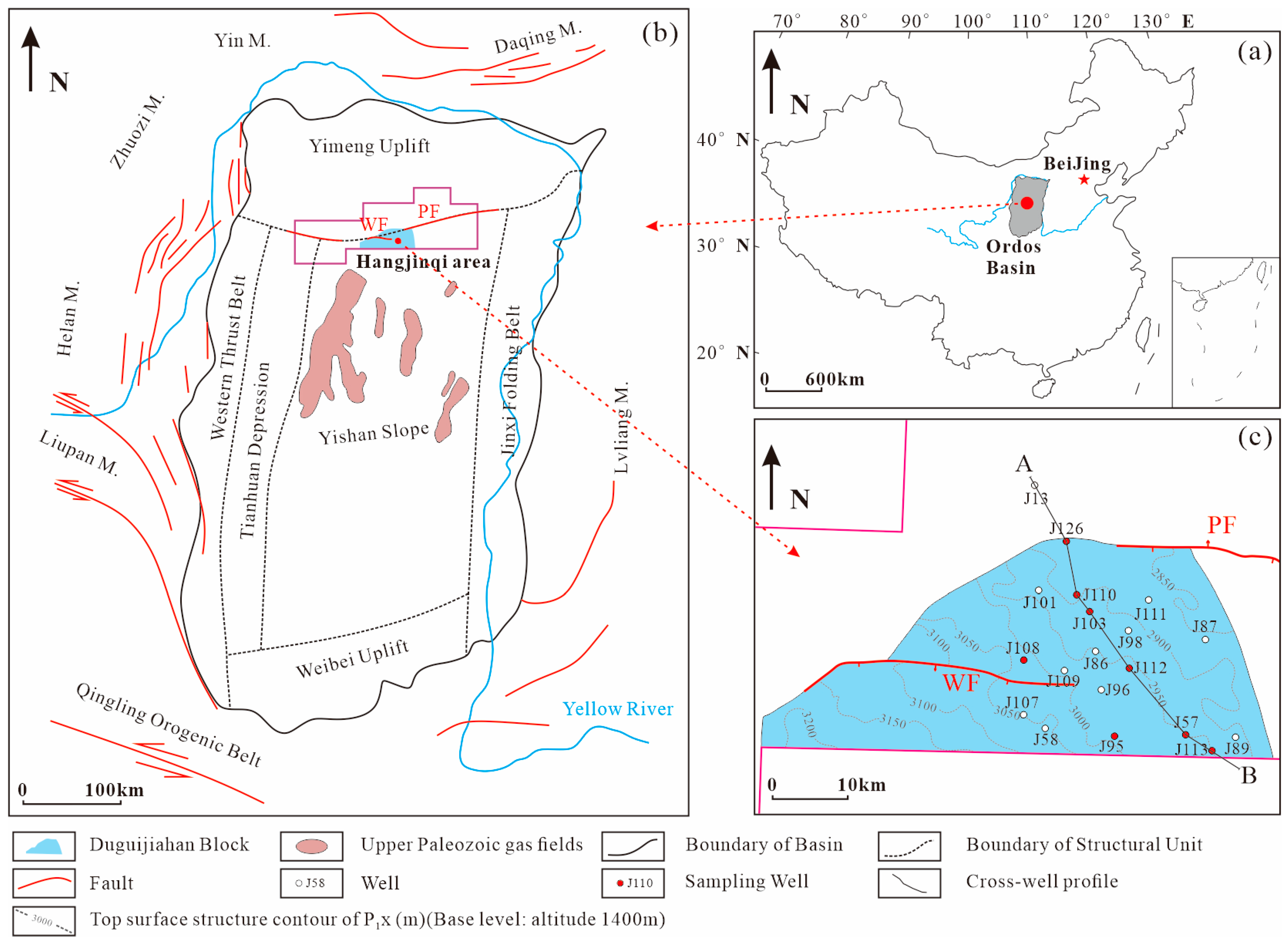

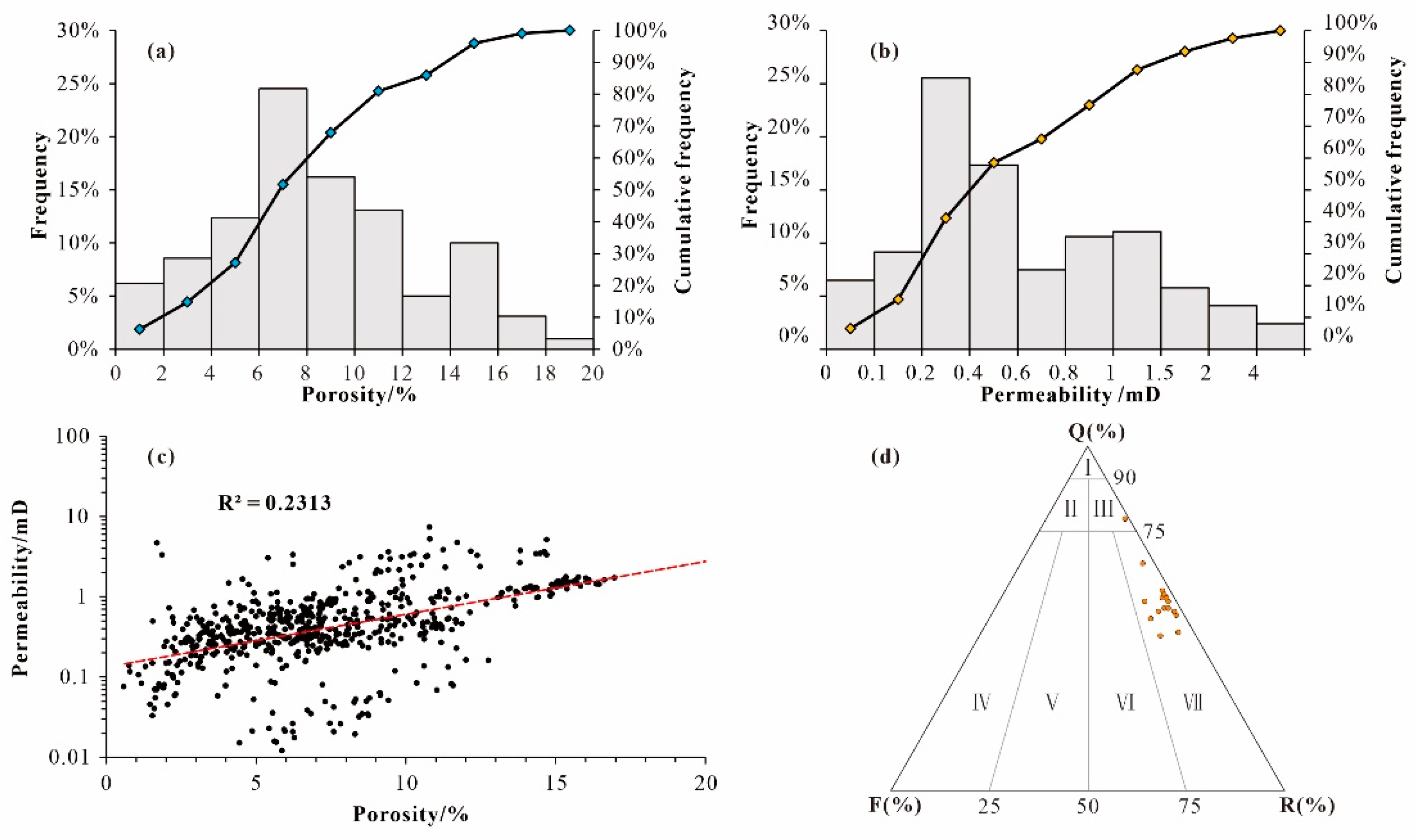
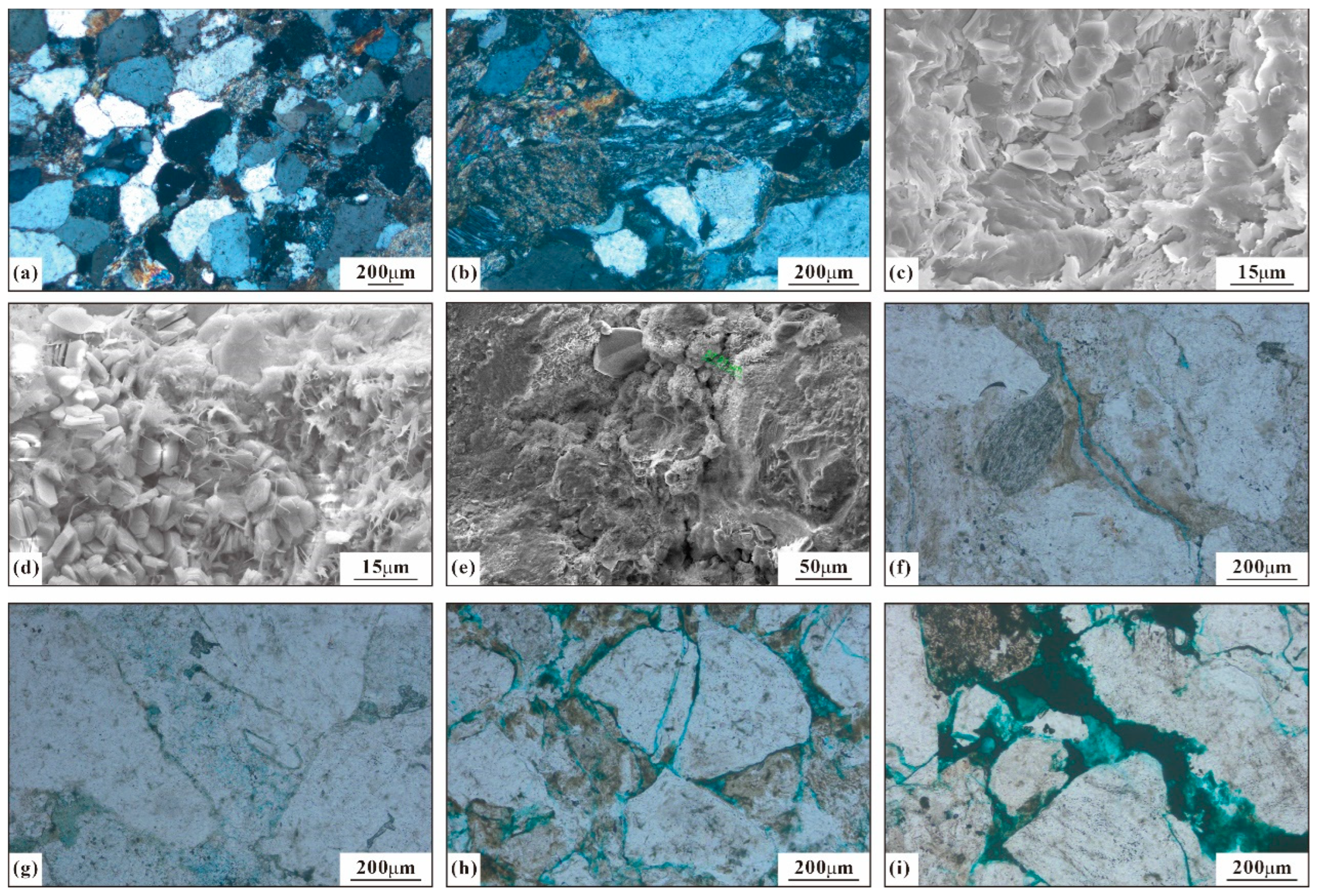
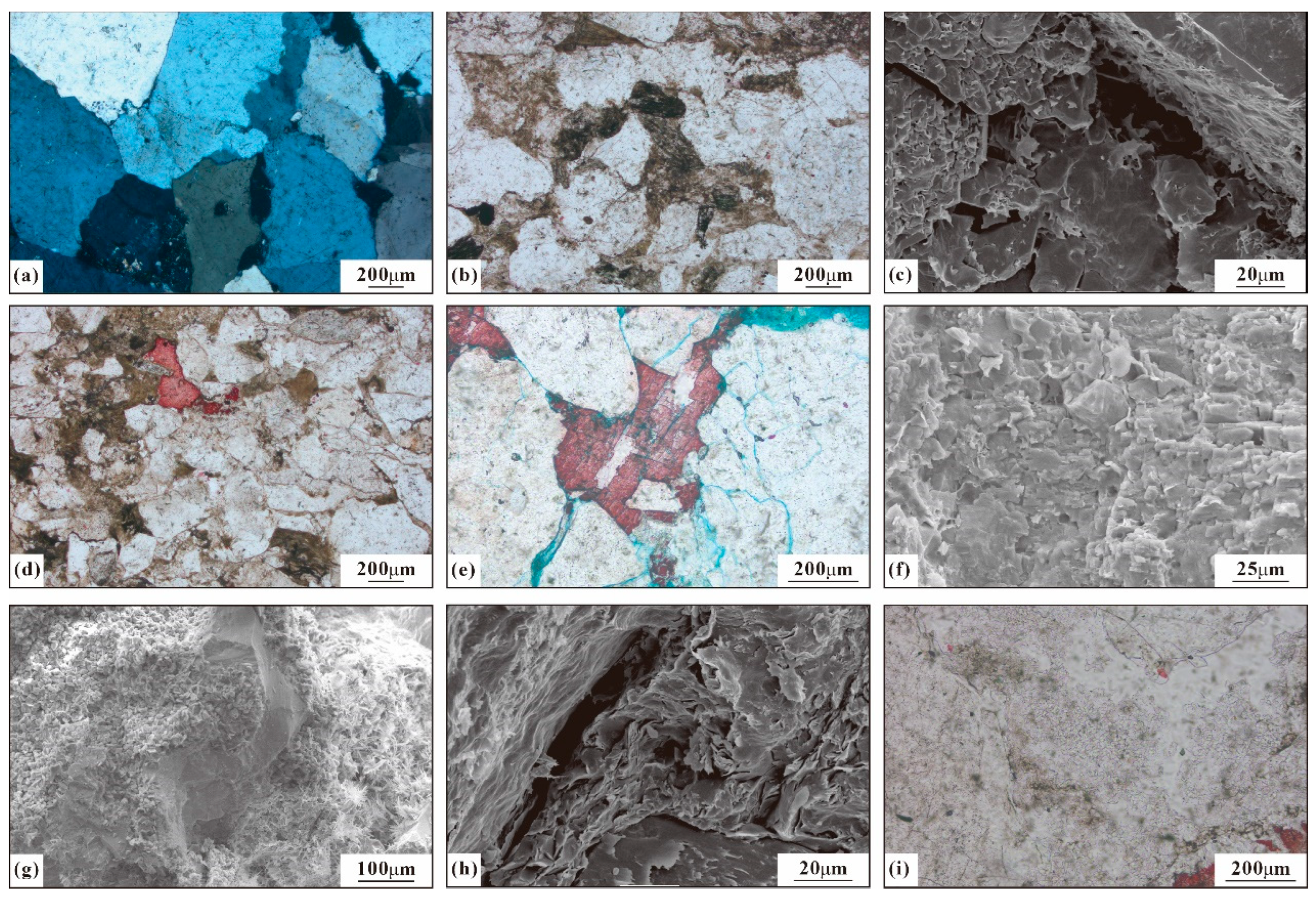

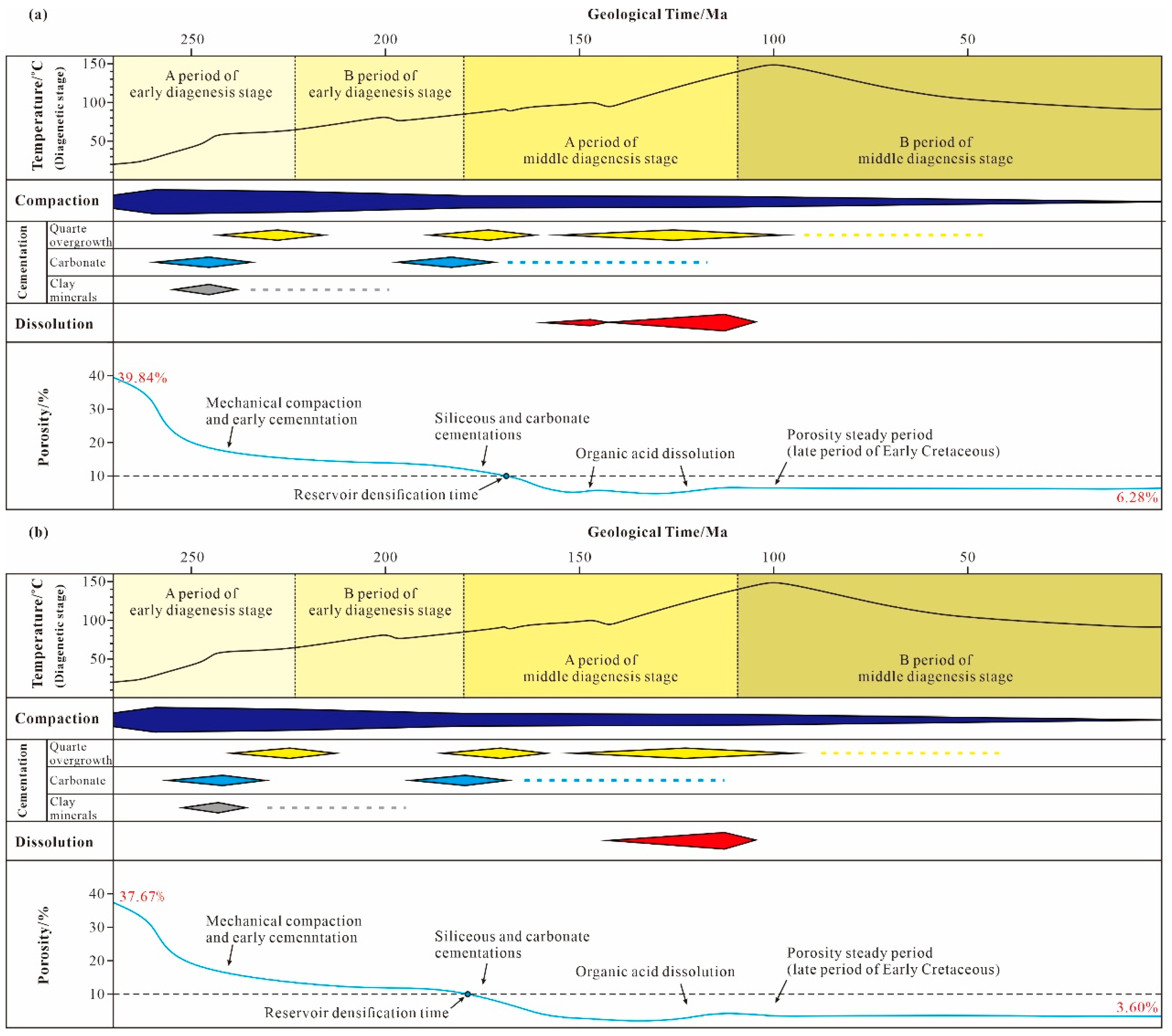

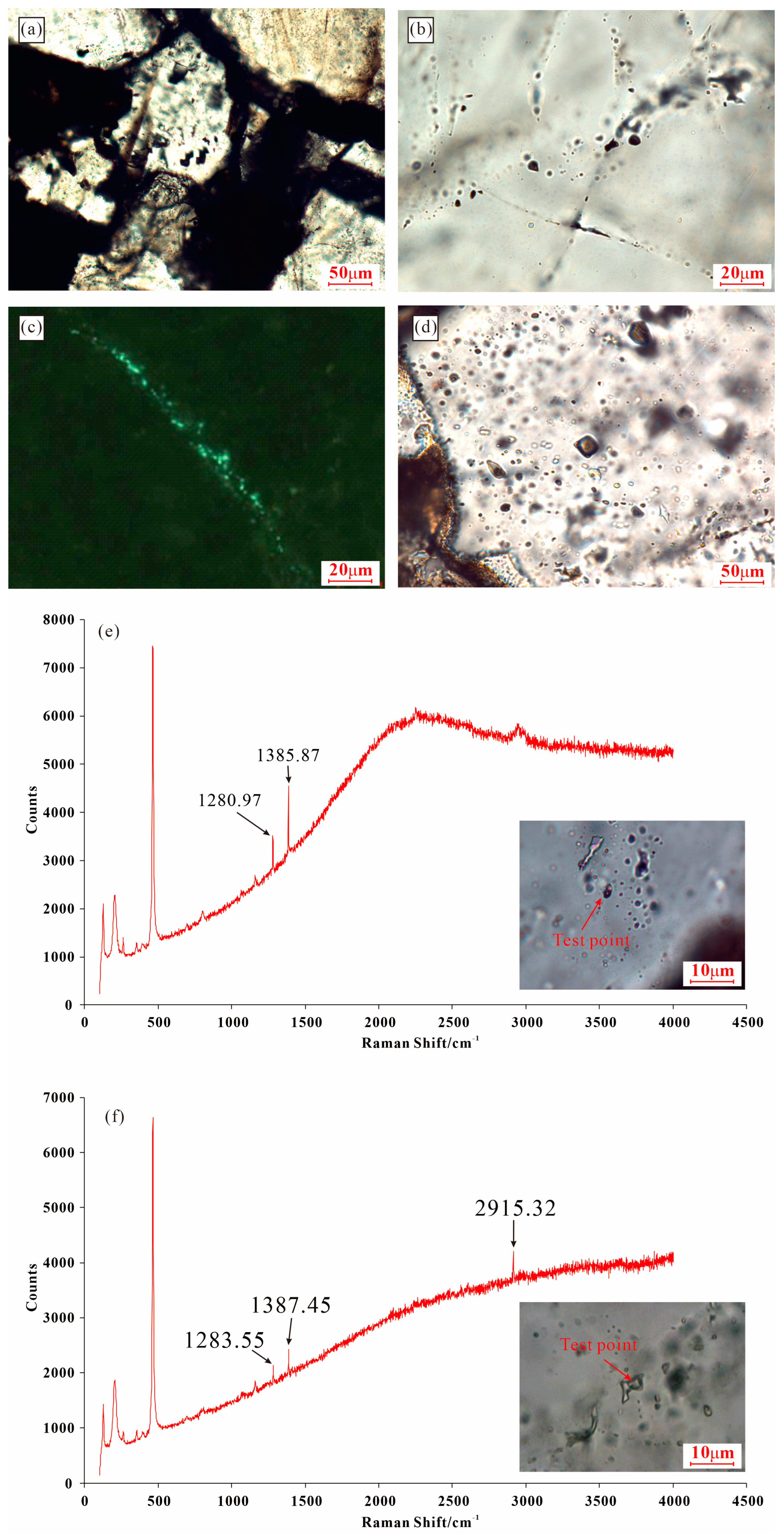
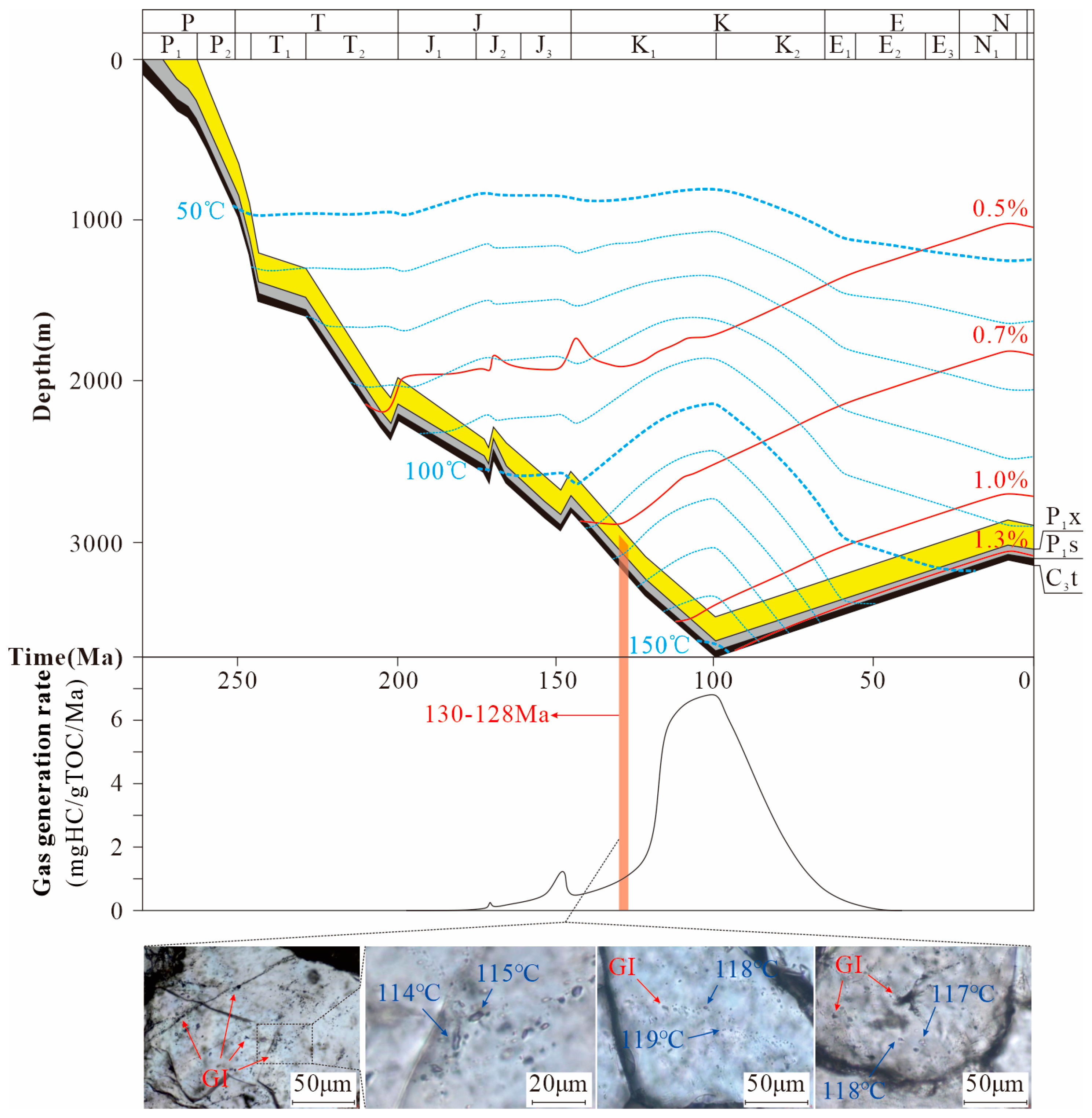
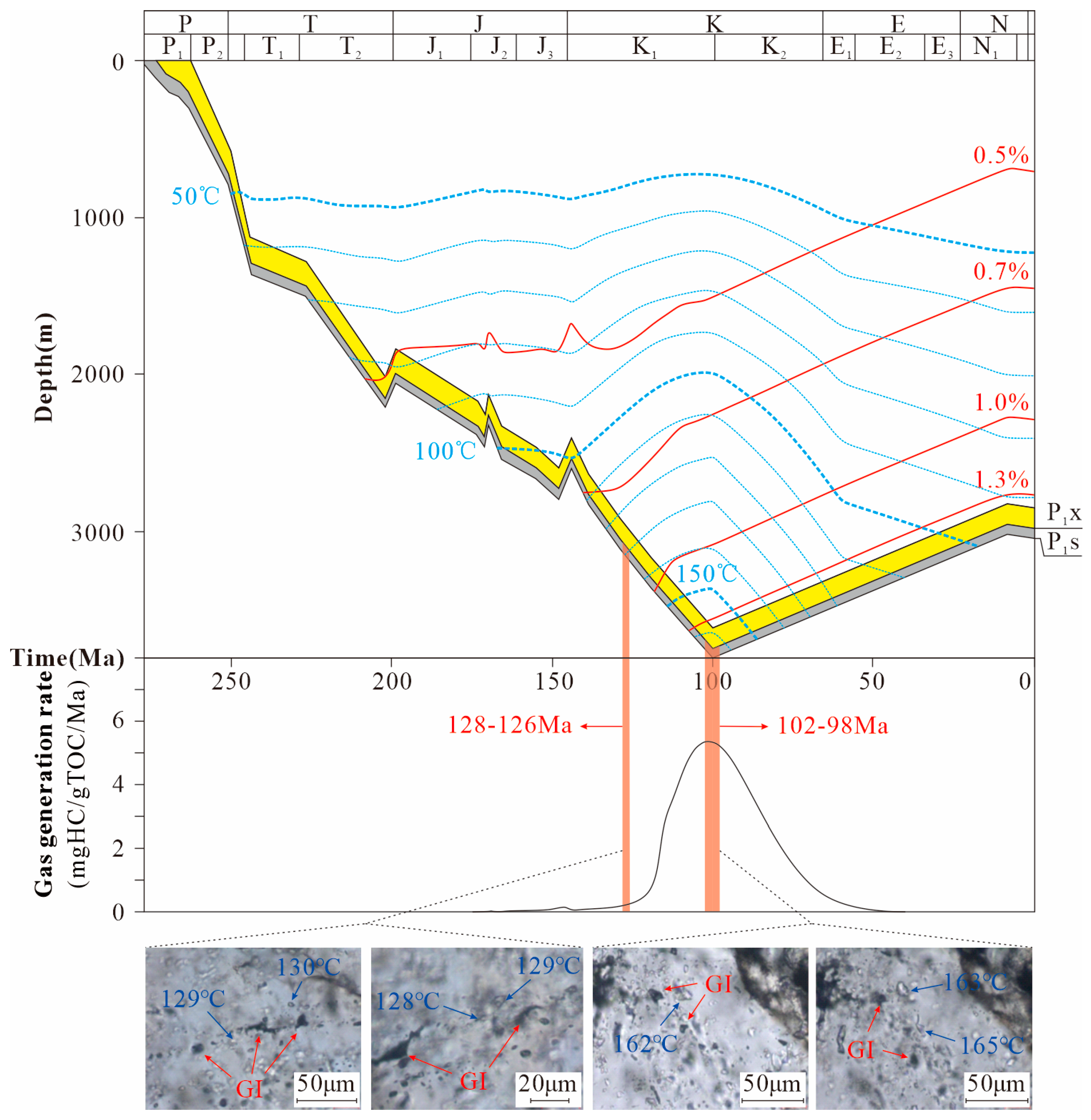



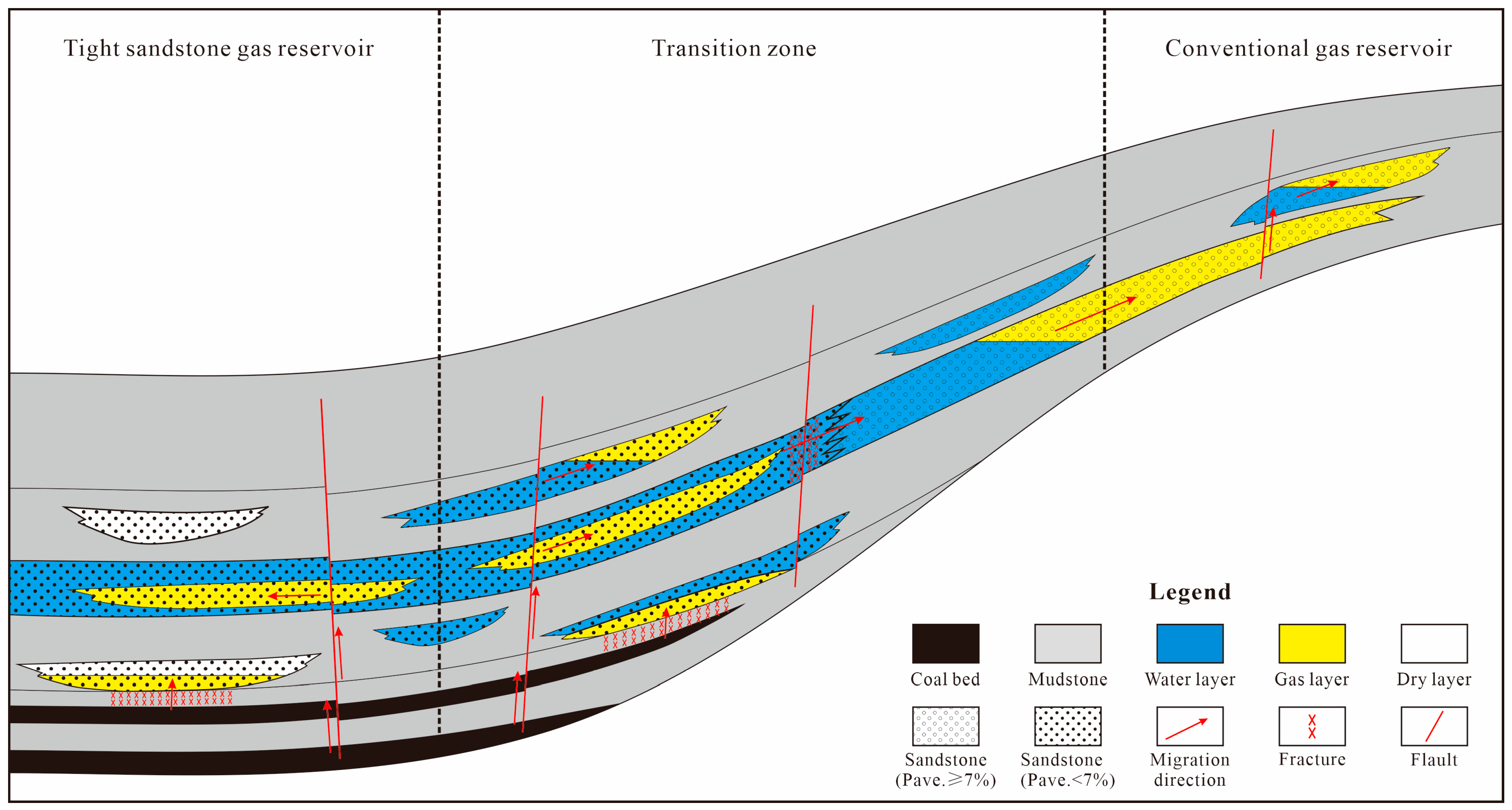
| Well | Depth (m) | Terrigenous Debris | Fillings | Thin-Section Porosity (%) | |||||||||||||||
|---|---|---|---|---|---|---|---|---|---|---|---|---|---|---|---|---|---|---|---|
| Q | Ch. | K-F | Pla. | Rock Fragment | Total | Heterobase | Cements | Total | |||||||||||
| Ig. | Me. | Se. | MG. | Total | Ar. | Ca. | Cal. | Kao. | Sid. | QSE. | |||||||||
| J57 | 2990 | 55 | √ | 6 | 2 | 4 | 28 | 5 | √ | 37 | 86 | 2 | / | 6 | 3 | √ | √ | 11 | 3 |
| J57 | 2996.3 | 50 | √ | 8 | 1 | 4 | 34 | 3 | √ | 41 | 88 | 4 | / | 1 | 1 | √ | √ | 6 | 6 |
| J95 | 3113 | 44 | 1 | 8 | 1 | 5 | 36 | 3 | 2 | 46 | 96 | 3 | / | √ | 1 | √ | √ | 4 | / |
| J95 | 3203.7 | 51 | 1 | 5 | 1 | 4 | 35 | 3 | √ | 42 | 92 | 7 | / | / | / | 1 | √ | 8 | √ |
| J95 | 3206.5 | 50 | 1 | 2 | / | 6 | 37 | 4 | √ | 47 | 91 | 6 | / | 2 | 1 | √ | √ | 9 | √ |
| J103 | 3081.5 | 65 | 1 | 3 | / | 8 | 19 | 4 | √ | 31 | 85 | 3 | / | 8 | 1 | √ | √ | 12 | 3 |
| J103 | 3087.3 | 45 | 1 | 4 | / | 4 | 38 | 6 | 2 | 50 | 86 | 12 | / | 2 | / | √ | √ | 14 | √ |
| J108 | 3143.7 | 51 | 5 | 3 | / | 6 | 31 | 4 | √ | 41 | 89 | 11 | / | / | / | / | √ | 11 | √ |
| J108 | 3151.5 | 52 | 1 | 4 | / | 5 | 32 | 6 | √ | 43 | 86 | 13 | / | 1 | / | √ | √ | 14 | √ |
| J110 | 3022.5 | 55 | 1 | 2 | / | 4 | 33 | 5 | √ | 42 | 89 | 3 | / | 6 | 2 | √ | √ | 11 | √ |
| J110 | 3030.5 | 57 | 1 | 2 | / | 5 | 29 | 6 | √ | 40 | 86 | 2 | / | 5 | 6 | √ | √ | 13 | 1 |
| J112 | 3130.5 | 51 | 1 | 2 | / | 4 | 37 | 5 | √ | 46 | 91 | 7 | / | 1 | 1 | √ | √ | 9 | √ |
| J112 | 3136.1 | 52 | 3 | 2 | / | 5 | 32 | 6 | √ | 43 | 89 | 8 | / | 1 | 1 | √ | √ | 10 | 1 |
| J113 | 3069.3 | 55 | 2 | 2 | / | 4 | 33 | 4 | √ | 41 | 92 | 6 | / | 1 | 1 | √ | √ | 8 | √ |
| J113 | 3074.78 | 55 | 2 | 2 | / | 5 | 30 | 6 | √ | 41 | 84 | 4 | / | 12 | / | √ | √ | 16 | / |
| J126 | 2896.55 | 52 | 1 | 3 | / | 4 | 35 | 5 | √ | 44 | 89 | 11 | / | √ | / | √ | √ | 11 | √ |
| J126 | 2901 | 51 | 1 | 2 | / | 6 | 37 | 3 | √ | 46 | 94 | 1 | / | 1 | 2 | √ | √ | 4 | 2 |
| J126 | 2917.23 | 76 | 3 | 1 | / | / | 20 | / | / | 20 | 90 | 1 | / | / | 1 | / | √ | 2 | 8 |
| J126 | 2938.78 | 55 | 1 | 2 | / | 6 | 32 | 4 | √ | 42 | 89 | 3 | / | 1 | 4 | √ | √ | 8 | 3 |
| Well | Depth/m | Strata | φo | φcomp | φcemt | φdiss | φp |
|---|---|---|---|---|---|---|---|
| J110 | 3030.5 | P1x1 | 37.67 | 20.99 | 14.48 | 1.40 | 3.60 |
| J110 | 3022.5 | P1x1 | 38.51 | 24.35 | 11.22 | 0.76 | 3.70 |
| J57 | 2990 | P1x3 | 38.63 | 15.88 | 12.63 | 1.40 | 11.52 |
| J57 | 2996.3 | P1x3 | 39.84 | 29.14 | 5.82 | 1.40 | 6.28 |
| Well | Depth (m) | Host Minerals | Position | Type | Fluorescence Color | Homogenization Temperatures (°C) | Gas Composition | |
|---|---|---|---|---|---|---|---|---|
| HC Inclusion | Coeval Brine Inclusion | |||||||
| J57 | 2996.3 | Quartz | healed microfractures | GI | / | / | 107–108 | CO2 |
| J57 | 2996.3 | Quartz | overgrowth | OI | yellow | <60.0 | 93.0/118–119 | / |
| J57 | 2996.3 | Quartz | overgrowth | GI | / | / | 93.0/118–119 | CO2/CH4 |
| J57 | 2996.3 | Quartz | overgrowth | O&G | yellow-green | 102–104.3 | 114 | CO2/CH4 |
| J57 | 2996.3 | Quartz | overgrowth | OI | weak yellow | / | 114 | / |
| J57 | 2996.3 | Quartz | overgrowth | GI | / | / | 94.0–95.0 | CO2 |
| J103 | 3085.1 | Quartz | healed microfractures | O&G | yellow-green | 110.4 | 101 | CO2 |
| J103 | 3085.1 | Quartz | healed microfractures | O&G | yellow-green | 111.8 | 101 | CO2 |
| J103 | 3085.1 | Quartz | healed microfractures | O&G | yellow-green | 112 | 101 | CO2 |
| J103 | 3085.1 | Quartz | healed microfractures | O&G | yellow-green | 119 | 101 | CO2 |
| J103 | 3085.1 | Quartz | healed microfractures | O&G | yellow-green | 148 | 101 | CO2 |
| J103 | 3085.1 | Quartz | healed microfractures | O&G | yellow-green | >200.0 | 96 | CO2 |
| J103 | 3085.1 | Quartz | healed microfractures | O&G | yellow-green | 106 | 96 | CO2 |
| J103 | 3085.1 | Quartz | healed microfractures | O&G | yellow-green | 99 | 96 | CO2 |
| J103 | 3085.1 | Quartz | healed microfractures | O&G | yellow-green | 101 | 131–134 | CH4 |
| J103 | 3085.1 | Quartz | healed microfractures | GI | / | / | 124–129 | CH4 |
| J110 | 3030.3 | Quartz | overgrowth | GI | / | / | 128–130 | CH4 |
| J110 | 3030.3 | Quartz | overgrowth | GI | / | / | 128–129 | CH4 |
| J110 | 3030.3 | Quartz | overgrowth | GI | / | / | 162–165 | CH4 |
| J112 | 3130.5 | Quartz | overgrowth | GI | / | / | 99–101/117–119 | CO2/CH4 |
| J112 | 3130.5 | Quartz | overgrowth | OI | weak yellow | / | 99–101/117–119 | / |
| J112 | 3130.5 | Quartz | overgrowth | GI | / | / | 148–149 | CH4 |
| Comparison Parameters | Well | Depth (m) | Strata | Measured Value | Simulation Value | Error Rate |
|---|---|---|---|---|---|---|
| Ro (%) | J78 | 3160.4 | C3t | 1.34 | 1.36 | −1.49% |
| J78 | 3161.6 | C3t | 1.35 | 1.36 | −0.74% | |
| J89 | 3169.4 | C3t | 1.17 | 1.16 | 0.85% | |
| J89 | 3167.5 | C3t | 1.16 | 1.16 | 0.00% | |
| Temperature (°C) | J57 | 3055 | P1x | 91.246 | 92.55 | −1.43% |
| J103 | 3075.75 | P1x | 93.552 | 91.51 | 2.18% | |
| J110 | 3021 | P1x | 94.646 | 96.21 | −1.65% | |
| J112 | 3113.75 | P1x | 87.276 | 87.93 | −0.75% |
| Zone | Well | C1 | C2 | C3 | iC4 | nC4 | iC5 | nC5 | Relatively Density | C1/C1–5 |
|---|---|---|---|---|---|---|---|---|---|---|
| Southern part | J31 | 10.774 | 0.858 | 0.203 | 0.029 | 0.041 | 0.016 | 0.011 | 0.9279 | 0.903 |
| J57 | 87.073 | 4.378 | 1.942 | 0.384 | 0.598 | 0.225 | 0.175 | 0.639 | 0.919 | |
| J58 | 78.389 | 2.311 | 0.938 | 0.124 | 0.237 | 0.077 | 0.063 | 0.658 | 0.954 | |
| J78 | 32.518 | 1.124 | 0.205 | 0.128 | 0.854 | 0.957 | ||||
| J85 | 55.669 | 7.742 | 1.601 | 0.201 | 0.299 | 0.145 | 0.135 | 0.763 | 0.846 | |
| J95 | 87.571 | 9.083 | 2.208 | 0.307 | 0.518 | 0.159 | 0.154 | 0.637 | 0.876 | |
| J96 | 93.439 | 3.184 | 0.5 | 0.137 | 0.32 | 0.052 | 0.044 | 0.605 | 0.957 | |
| J107 | 94.943 | 3.18 | 0.695 | 0.223 | 0.24 | 0.081 | 0.066 | 0.591 | 0.955 | |
| J115 | 89.713 | 6.581 | 1.834 | 0.298 | 0.544 | 0.234 | 0.156 | 0.629 | 0.903 | |
| Northern part | J86 | 94.845 | 2.075 | 0.447 | 0.07 | 0.05 | 0.029 | 0.056 | 0.584 | 0.972 |
| J98 | 92.528 | 5.5 | 0.935 | 0.137 | 0.201 | 0.085 | 0.066 | 0.603 | 0.930 | |
| J99 | 87.434 | 7.158 | 1.62 | 0.23 | 0.374 | 0.102 | 0.104 | 0.632 | 0.901 | |
| J100 | 89.172 | 7.464 | 1.787 | 0.306 | 0.647 | 0.249 | 0.378 | 0.633 | 0.892 | |
| J101 | 91.265 | 5.394 | 1.476 | 0.218 | 0.359 | 0.126 | 0.116 | 0.614 | 0.922 | |
| J103 | 87.612 | 6.821 | 1.489 | 0.22 | 0.344 | 0.145 | 0.118 | 0.629 | 0.906 | |
| J108 | 92.318 | 4.135 | 1.131 | 0.155 | 0.245 | 0.113 | 0.082 | 0.612 | 0.940 | |
| J110 | 93.821 | 2.947 | 0.668 | 0.253 | 0.229 | 0.058 | 0.026 | 0.603 | 0.957 | |
| J111 | 84.262 | 2.72 | 0.552 | 0.091 | 0.14 | 0.062 | 0.049 | 0.63 | 0.959 | |
| J112 | 92.097 | 2.264 | 0.468 | 0.122 | 4.215 | 0.597 | 0.929 | |||
| J114 | 90.997 | 7.052 | 1.146 | 0.14 | 0.189 | 0.069 | 0.053 | 0.61 | 0.913 | |
| J109 | 96.034 | 2.755 | 0.319 | 0.041 | 0.05 | 0.105 | 0.053 | 0.581 | 0.967 |
Disclaimer/Publisher’s Note: The statements, opinions and data contained in all publications are solely those of the individual author(s) and contributor(s) and not of MDPI and/or the editor(s). MDPI and/or the editor(s) disclaim responsibility for any injury to people or property resulting from any ideas, methods, instructions or products referred to in the content. |
© 2023 by the authors. Licensee MDPI, Basel, Switzerland. This article is an open access article distributed under the terms and conditions of the Creative Commons Attribution (CC BY) license (https://creativecommons.org/licenses/by/4.0/).
Share and Cite
Yu, H.; Ye, J.; Cao, Q.; Liu, Y.; Zhang, W. Study on the Tight Gas Accumulation Process and Model in the Transition Zone at the Margin of the Basin: A Case Study on the Permian Lower Shihezi Formation, Duguijiahan Block, Ordos Basin, Northern China. Energies 2023, 16, 1493. https://doi.org/10.3390/en16031493
Yu H, Ye J, Cao Q, Liu Y, Zhang W. Study on the Tight Gas Accumulation Process and Model in the Transition Zone at the Margin of the Basin: A Case Study on the Permian Lower Shihezi Formation, Duguijiahan Block, Ordos Basin, Northern China. Energies. 2023; 16(3):1493. https://doi.org/10.3390/en16031493
Chicago/Turabian StyleYu, Hanwen, Jiaren Ye, Qiang Cao, Yiming Liu, and Wei Zhang. 2023. "Study on the Tight Gas Accumulation Process and Model in the Transition Zone at the Margin of the Basin: A Case Study on the Permian Lower Shihezi Formation, Duguijiahan Block, Ordos Basin, Northern China" Energies 16, no. 3: 1493. https://doi.org/10.3390/en16031493
APA StyleYu, H., Ye, J., Cao, Q., Liu, Y., & Zhang, W. (2023). Study on the Tight Gas Accumulation Process and Model in the Transition Zone at the Margin of the Basin: A Case Study on the Permian Lower Shihezi Formation, Duguijiahan Block, Ordos Basin, Northern China. Energies, 16(3), 1493. https://doi.org/10.3390/en16031493






